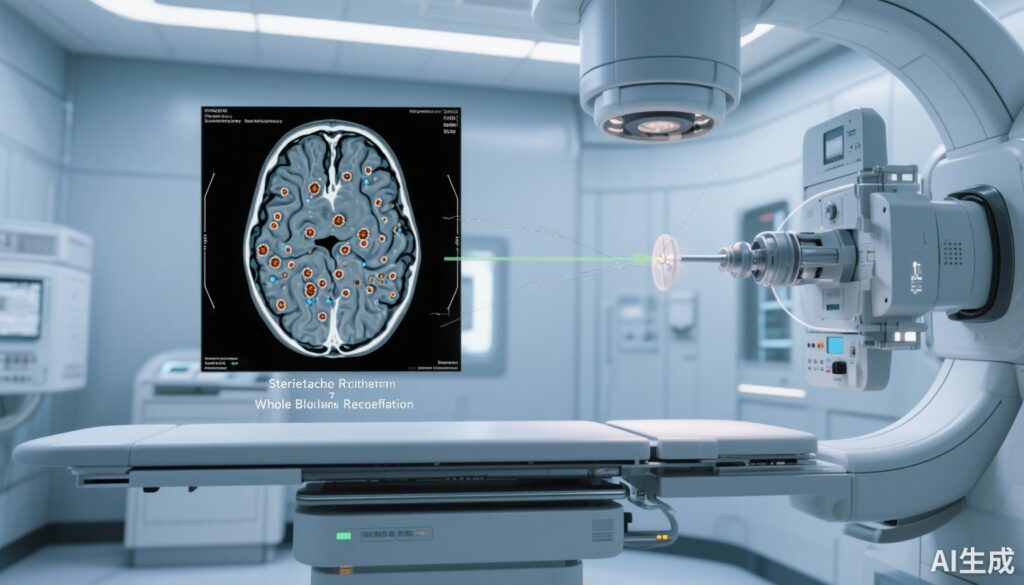Highlight
1. Stereotactic radiosurgery (SRS) achieves a 1-year neurologic death rate of 11.0% in small cell lung cancer (SCLC) patients with 1-10 brain metastases, lower than historical control rates with whole-brain radiation therapy (WBRT, 17.5%).
2. Only 22% of patients undergoing SRS required salvage WBRT, suggesting effective intracranial tumor control with stereotactic approaches.
3. Median overall survival was 10.2 months, demonstrating meaningful clinical outcomes despite SCLC’s aggressive nature.
4. The study supports close post-SRS surveillance coupled with stereotactic treatment as a feasible and less toxic alternative to WBRT in selected SCLC patients.
Study background and disease burden
Small cell lung cancer (SCLC) constitutes approximately 15% of lung cancer cases and is characterized by rapid proliferation, early dissemination, and a high propensity for brain metastases. Historically, brain involvement occurs in over 50% of patients during the disease course, often inflicting significant neurologic morbidity and mortality. Though systemic therapies have improved, the management of brain metastases in SCLC remains challenging.
Whole-brain radiation therapy (WBRT) has been the cornerstone of intracranial management in SCLC motivated by its ability to treat both visible metastases and microscopic disease, given the cancer’s high CNS predilection. However, WBRT is associated with notable neurocognitive decline and a detrimental impact on quality of life. In contrast, stereotactic radiosurgery (SRS), a highly focused radiation modality, has become standard for non-small cell lung cancer (NSCLC) brain metastases, offering less neurotoxicity and comparable control for limited brain metastases.
Despite SRS’s success in other histologies, its role in SCLC remains controversial due to a dearth of prospective data, concerns regarding multiple micrometastases, and feared increased intracranial failure or neurologic death without WBRT. This gap underlines an unmet need to rigorously evaluate SRS as a primary brain-directed therapy to balance efficacy with toxicity in SCLC patients harboring limited brain metastases.
Study design
This investigation was a single-arm, multicenter, phase II prospective clinical trial (ClinicalTrials.gov identifier: NCT03391362) conducted between February 2018 and April 2023. Its primary objective was to determine the rate of neurologic death among SCLC patients treated with stereotactic radiosurgery/radiotherapy (SRS/SRT) for 1 to 10 brain metastases, in comparison to historical WBRT controls.
Eligibility criteria included patients diagnosed with SCLC or an extrathoracic small cell primary tumor presenting 1-10 brain metastases. Key exclusion criteria were prior brain-directed radiation, including prophylactic cranial irradiation, to ensure a treatment-naïve intracranial setting.
Neurologic death was rigorously defined as progressive brain metastases confirmed radiographically, accompanied by neurological symptoms, in the absence of systemic disease progression or critical systemic illness. Patients were closely monitored with serial brain imaging post-intervention to detect intracranial progression early, enabling salvage therapeutic options when necessary.
Key findings
A total of 100 patients were enrolled, with a median of 2 brain metastases (interquartile range [IQR], 1-4; range, 1-10). The median age and other baseline demographics were consistent with typical SCLC populations, ensuring generalizability.
The median overall survival (OS) was 10.2 months, reflecting the natural aggressive course of SCLC. Importantly, only 22% of patients subsequently required salvage WBRT, indicating substantial intracranial disease control achieved with initial SRS/SRT.
Regarding safety and neurologic outcomes, 20 neurologic deaths occurred, compared with 64 non-neurologic deaths. The 1-year cumulative neurologic death rate was 11.0% (95% confidence interval [CI], 5.8 to 18.1), notably lower than the historical benchmark of 17.5% from WBRT-treated cohorts. This reduction suggests that vigilant surveillance and salvage strategies coupled with SRS can mitigate risks traditionally associated with withholding WBRT.
The study did not report comparative neurocognitive outcomes directly, but the lower neurotoxicity profile associated with SRS/SRT implies a potential quality-of-life advantage over WBRT. Additionally, the feasibility of repeated SRS or other focal therapies was not fully detailed but remains relevant for longitudinal intracranial disease management.
Expert Commentary
These results challenge the entrenched paradigm that WBRT must remain the default in SCLC patients with brain metastases due to presumed diffuse CNS involvement. This multi-institutional prospective study supports stereotactic radiosurgery as a viable alternative for patients with limited brain metastases (up to 10 lesions), emphasizing the importance of close post-treatment neuroimaging surveillance to detect and address intracranial progression promptly.
Experts in neuro-oncology and radiation oncology note that restricting WBRT could preserve neurocognitive function and reduce treatment-related morbidity without increasing neurologic mortality, representing a significant clinical advance. However, limitations to consider include the single-arm design without concurrent WBRT controls, potential selection bias favoring patients with more indolent disease, and the need for validation in randomized controlled trials.
Biological plausibility for these findings rests on advances in imaging, radiosurgical precision, and systemic therapies that better control extracranial disease, collectively improving overall outcomes. The definition of neurologic death is stringent, ensuring that the endpoint accurately reflects brain-specific mortality rather than confounded systemic progression.
Conclusion
The prospective, multicenter phase II trial provides compelling evidence that stereotactic radiosurgery or radiotherapy can be safely and effectively employed in select patients with SCLC and 1-10 brain metastases. With a low neurologic death rate and limited need for salvage whole-brain radiation, SRS/SRT emerges as a promising brain-directed therapy that may reduce the neurocognitive sequelae historically linked to WBRT.
These findings prompt reconsideration of current treatment algorithms and encourage integration of stereotactic approaches into multidisciplinary care for brain metastases in SCLC. Future randomized studies with neurocognitive endpoints will be critical to confirm these benefits and refine patient selection criteria. Meanwhile, consistent brain imaging surveillance is paramount to promptly identify intracranial progression and apply salvage interventions as needed.
References
1. Aizer AA, Tanguturi SK, Shi DD, et al. Stereotactic Radiosurgery in Patients With Small Cell Lung Cancer and 1-10 Brain Metastases: A Multi-Institutional, Phase II, Prospective Clinical Trial. J Clin Oncol. 2025 Sep 20;43(27):2986-2997. doi: 10.1200/JCO-25-00056. Epub 2025 Jul 11. PMID: 40644657.
2. Chang EL, Wefel JS, Hess KR, et al. Neurocognition in patients with brain metastases treated with radiosurgery or radiosurgery plus whole-brain irradiation: a randomized controlled trial. Lancet Oncol. 2009 Nov;10(11):1037-44.
3. NCCN Clinical Practice Guidelines in Oncology. Central Nervous System Cancers. Version 1.2025.
4. Ballman KV. Sample size determination for phase II clinical trials. Stat Methods Med Res. 2015 Apr;24(2):204-25.



